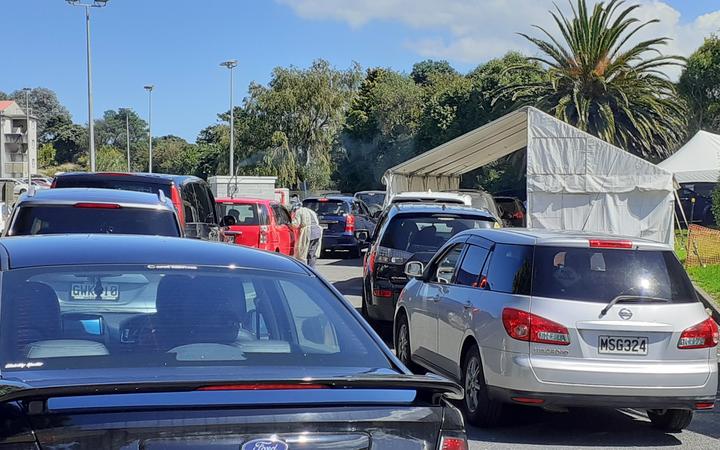Covid-19 is spreading fastest among children and teens in the Whanganui and Rangitīkei Covid-19 outbreak as the region faces the second-lowest rate of child 5 to 11 vaccinations in the country.

A long line of cars, many with children, queued for testing in the grounds of Whanganui Hospital yesterday. Photo: LDR / Moana Ellis
Ministry of Health data shows of 65 active cases confirmed up to 3pm on Wednesday in the Whanganui District Health Board region, the 10 to 19 years age-group is recording the highest number of cases at 19. Another nine are aged nine or younger.
Vaccinations for children aged five to 11 have reached only 33 percent across the DHB region. As a comparison, five DHBs have rates of between 50 percent and 62.3 percent.
Among Māori, the rate is only 20.6 percent, also the second lowest in the country with only 557 tamariki vaccinated. The rate for Pasifika at 25.6 percent is the worst in the country.
In Rangitīkei, the DHB region’s biggest Covid-19 cluster is linked to a workplace and James Cook primary school in Marton. However, the township’s 27 confirmed cases could soon be eclipsed by growing numbers in Whanganui, where 25 cases have been confirmed.

Whanganui primary school Carlton School, Whanganui High School and Whanganui Collegiate have confirmed cases.
Whanganui DHB chief executive Russell Simpson said while the numbers in those age groups were not surprising, the low vaccination uptake among children was concerning.
“When we are second to bottom in the country around the number who are being vaccinated, it is a concern.”
Simpson said the age groups at risk tended to socialise more, were more mobile in the community, and were at school where there were large cohorts of people in one area.
“If schools maintain best practice around public health measures it does mitigate the risk of transmission through a school community,” he said.
Next to the 10-19 years age group, the highest number of cases was reported among those aged 30-39, with 11 cases. The full list is:
- 0-9 years – 9 cases;
- 10-19 years – 19 cases;
- 20-29 years – 9 cases;
- 30-39 years – 11 cases;
- 40-49 years – 9 cases;
- 50-59 years – 2 cases;
- 60-69 years – 2 cases;
- 70-79 years – 4 cases.
Simpson said the DHB had strategies in place to lift vaccination rates, but the decision to vaccinate rested with a parent or individual.
“We have the capacity to deliver the vaccinations. It’s individual choice as to whether someone wishes to take that up or not.
“We have clinics available on a regular basis to target the hard-to-reach group, we have mobile clinics throughout the district, we have flexible hours … but capacity’s not the issue. It’s the people rolling up their sleeves to get vaccinated that is the issue.
“I would like to see a greater uptake in our vaccinations particularly across our tamariki, because that does concern me.
“What has been demonstrated through the adult vaccinations, though, is that uptake has been slower. We have got over that 90 percent vaccination rate – but it has taken longer than other districts.”
Local Democracy Reporting is Public Interest Journalism funded through NZ On Air